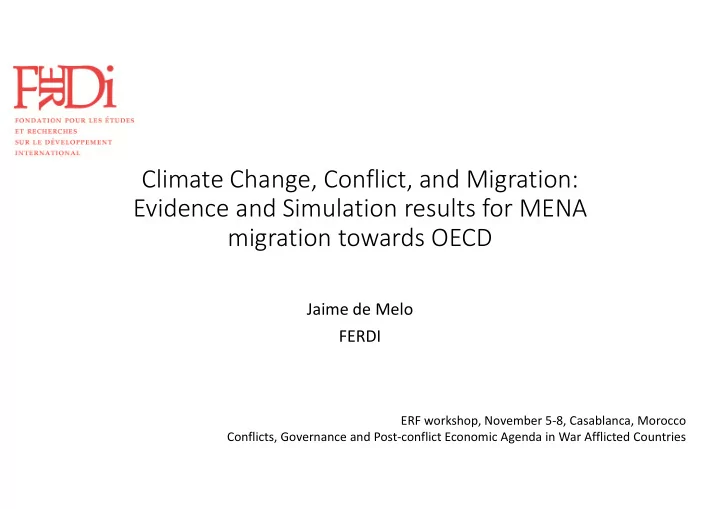

Climate Change, Conflict, and Migration: Evidence and Simulation results for MENA migration towards OECD Jaime de Melo FERDI ERF workshop, November 5‐8, Casablanca, Morocco Conflicts, Governance and Post‐conflict Economic Agenda in War Afflicted Countries
Outline • Literature Review • Climate change and migration • Climate change and conflict • Modelling Climate Change (CLC): • Channels of transmission: temperature increase and sea level rise (SLR) • Sketch of OLG model (145 countries + OECD as one country for destination of migrants) • 3 scenarios (relative to a base of no CLC: minimalist‐no CLC [+0.09 0 ;+0m.]) • Maximalist [+4.09 0 ;1.3M] • Intermediate: [+2.09 0 ;1.1M] • Extreme‐Utility [+4.09 0 ;1.3M;+ utility losses] • Extreme‐Conflict [+4.09 0 ;1.3M;+ utility losses; + conflict in poorest] Results
Literature Review: CLC and migration Mix of case studies and cross‐country econometric studies (See paper ) Contrasted findings with small migration responses on slow‐onset CLC (except historical—See Faigan 2008) Strong, but usually temporary migration, for fast‐onset events (storms surges, floods) Beine‐Jeusette (2018) meta‐analysis unravels components resulting in contrasted findings Limitations of econometric studies based on past data Slow‐onset CLC at early stages Distinguishing between climate and other factors difficult Mobility responses are context‐specific (geography, development, network, cultural, socio‐economic) Paper: ‘Quantitative theory’ to simulate some likely effects on migration over 21 st . C. in a world model
Literature Review: CLC and Conflict (55 studies) Burke, Hsiang, Miguel “Climate and Conflict”, ARE 2017 High degree of agreement across 55 panel studies that high temperatures and other extreme climate outcomes associated with more violence : +2 0 C predicted by 2050 (≈3σ). In simulations, we take the mean result of this meta study: +1 σ increases probability of conflict by 11%
Objectives and Focus • Estimate internal and international mobility responses to long‐term, slow‐ onset CLC under current law and enforcement policies ‘validated’ by backtracking simulations for 2010 and socio‐economic projections uptto 2040. • Simplifying assumptions about CLC • Exogenous CLC (no feedback from growth and urbanization on CLC) • Long‐term direct CLC=Rise in temperature + SLR • Indirect effects via utility loss and conflicts • Focus on migration decisions via mechanisms recognized in theoretical and empirical literature • Role of migration costs • Fertility and education response • Distribution implications via 2 types of labor: skilled and unskilled
Why Link migration (and conflict) to CLC • Heading to uncharted territory • Surface temperature is rising at an accelerated rate since 1980 • SLR has also accelerated sharply since ≈2000 due to loss of antartic sheet in West Antarctica (see next slides) • Many economic implications documented in Dell et al. (2014) o Redistribution of TFP towards higher latitudes o Health/drudgery of work (modelled here as utility loss) o Conflicts • Heterogeneous effects across areas/sectors w/n & across countries
Contribution • Granularity in CLC (temp +SLR) (1kmX1km) and in economic structure • Disentangle contributing factors: displacements from flooded areas vs. economic migration • TFP and forced displacement vs. ‘less firmly’ rooted effects (utility loss and conflicts) • Two‐sector model (agriculture/non‐agriculture) two‐class (skill/unskill), two area (flooded/unflooded) OLG model over 21 st C solved by backward deduction over 30 yrs period: 2040,2070,2100) • Modelling shortcuts : No trade &no relative prices between Ag and non‐ag • Contribution: Reasonably suggestive predictions about likely effects and international migration responses to CLC for 145 countries to OECD countries (treated as 1 country)
Temperature paths under RCP4.5 Distribution of changes in temperature by country and latitude in 2100
Sea level rise
Population shares living below 1.1 m in 2010 (10 bins)
Population shares living between 1.1m & 1.3m in 2100 (10 bins)
MENA in second most vulnerable group of countries
Channels of Transmission (1): Temperature and Productivity (as in Desmet and Rossi‐Hansberg (2015)) Agriculture Productivity and Temperature Non‐ Agriculture 9.4 0 < 21.1 0 < 32.9 0 Range ‐3 0 < 17.4 0 < 38 0
Channels of Transmission (2) • Temperature and utility Output per worker falls by 2% per +1 0 when above 22 0 • • Use of NASA data to identify share of population per elevation • Relocation costs for forcibly displaced people: lose B=0.5 of their labor earnings • One σ increase in temperature raises intergroup conflict by 11.3 percent in selected countries (here the 10 poorest)‐From Burke et al. meta‐analysis • Long‐term conflicts captured by a reduction in int’l migration costs so as to raise emigration stocks by a factor of 2
Model Structure
Preferences
Results
Global Migration under extreme scenarios (utility loss and utility loss + conflict)
Worldwide responses (moderate scenarios) • Small effects on income per worker, population growth and education (See paper) Urbanization share share of international migrants to OECD ↓ ↓
Country‐specific effects by latitude Income per capita Emigration rates ↓ ↓
Worldwide responses (extreme scenarios) • Large effects of utility losses/conflicts Urbanization share Share of international migrants to OECD ↓ ↓
Effects on Poverty headcounts (1)
Effects on poverty headcounts
Per capita income in MENA (ratios to Min‐no CLC—Conflict here only in 10 poorest countries in sample)
Conclusions
Climate Change, inequality andMigration Towards OECD Countries Michal Burzinski Christoph Deuster Frédéric Docquier Jaime de Melo
Recommend
More recommend